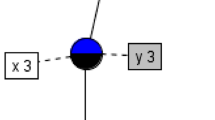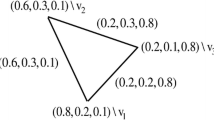Abstract
In recent year, the mathematics of three-way fuzzy concept lattice is introduced to characterize the attributes based on its acceptation, rejection and uncertain part. One of the suitable example is descriptive analysis of opinion of people in a democratic country. This became complex for the country like India where opinion (i.e. vote) of people to choose the particular leader is based on 29 independent states and their distinct issues. Adequate analysis of these type of 29-valued data based on its acceptation, rejection and uncertain part is major issue for the government and private agencies. To resolve this issue current paper introduces n-valued neutrosophic context and its graphical structure visualization for descriptive analysis. In the same time an another method is proposed to some of the similar three-way n-valued concepts. To zoom in and zoom out the n-valued neutrosophic context at user required information granules with an illustrative example.




Similar content being viewed by others
Explore related subjects
Discover the latest articles, news and stories from top researchers in related subjects.Notes
References
Alkhazaleh S (2017) N-Valued refined neutrosophic soft set theory. J Intell Fuzzy Syst 32(6):4311–4318
Alkhazaleh S, Hazaymeh A (2018) N-valued refined neutrosophic soft sets and their applications in decision making problems and medical diagnosis. J Artif Intell Soft Comput Res 8(1):79–86
Ascar E, Yener B (2009) Unsupervised multiway data analysis: a literature survey. IEEE Trans Data Knowl Eng 1(1):6–20
Antoni L, Krajči S, Krídlo O, Macek B, Piskova L (2014) On heterogeneous formal contexts. Fuzzy Sets Syst 234:22–33
Bělohlávek R (2004) Concept lattices and order in fuzzy logic. Ann Pure Appl Logic 128(1–3):277–298
Burusco A, Fuentes-Gonzalez R (1994) The study of the L-fuzzy concept lattice. Mathew Soft Comput 1(3):209–218
Broumi S, Deli I, Smarandache F (2015) N-valued interval neutrosophic sets and their application in medical diagnosis. Crit Rev Cent Math Uncertainty Creighton Univ USA 10:46–69
Broumi S, Son LH, Bakali A, Talea M, Smarandache F, Selvachandran G (2017) Computing operational matrices in neutrosophic environments: a matlab toolbox. Neutrosoph Sets Syst 18:58–66
Broumi S, Bakali A, Talea M, Smarandache F (2017) Shortest path problem on single valued neutrosophic graphs. In: International symposium on networks, computers and communications (ISNCC): wireless and mobile communications and networking 978-1-5090-4260-9/17/31.00. pp 1–6. https://doi.org/10.1109/ISNCC.2017.8071993
Chen J, Li S, Ma S, Wang X (2014) \(m\)-polar fuzzy sets: an extension of bipolar fuzzy sets. Sci World J. https://doi.org/10.1155/2014/416530
Djouadi Y, Prade H (2011) Possibility-theoretic extension of derivation operators in formal concept analysis over fuzzy lattices. Fuzzy Optim Decis Making 10:287–309
Ganter B, Wille R (1999) Formal concept analysis: mathematical foundation. Springer, Berlin
Kandasamy WBV, Ilanthenral K, Smarandache F (2015) Neutrosophic graphs: a new dimension to graph theory, Kindle edn. EuropaNova ASBL, Clos du Parnasse, 3E (ISBN-13: 978-1-59973-362-3)
Kroonenberg PM (2008) Applied multiway data analysis. Wiley, Oxford
Liu D, Li T, Ruan D (2011) Probabilistic model criteria with decision-theoretic rough sets. Inf Sci 181:3709–3722
Liu D, Liang D (2017) Three-way decisions in ordered decision system. Knowl Based Syst 137:182–195
Li JH, Huanga C, Qi J, Qian J, Liu W (2017) Three-way cognitive concept learning via multi-granularity. Inf Sci 378:244–263
Ma L, Mi JS, Xie B (2017) Multi-scaled concept lattices based on neighborhood systems. Int J Mach Learn Cybern 8(1):149–157
Pedrycz W, Chen SM (2015) Granular computing and decision-making: interactive and iterative approaches. Springer, Berlin
Singh PK, Gani A (2015) Fuzzy concept lattice reduction using Shannon entropy and Huffman coding. J Appl Non Class logic 25(2):101–119
Singh PK, Kumar CA, Gani A (2016) A comprehensive survey on formal concept analysis and its research trends. Int J Appl Math Comput Sci 26(2):495–516
Singh PK (2017) Three-way fuzzy concept lattice representation using neutrosophic set. Int J Mach Learn Cybern 8(1):69–79
Singh PK (2017) Complex vague set based concept lattice. Chaos Solitons Fract 96:145–153
Singh PK (2018) Medical diagnoses using three-way fuzzy concept lattice and their Euclidean distance. Comput Appl Math 37(3):3282–3306
Singh PK (2018) Interval-valued neutrosophic graph representation of concept lattice and its (\(\alpha, \beta, \gamma\))-decomposition. Arab J Sci Eng 43(2):723–740. https://doi.org/10.1007/s13369-017-2718-5
Singh PK (2018) \(m\)-polar fuzzy graph representation of concept lattice. Eng Appl Artif Intell 67:52–62
Singh PK (2018) Complex neutrosophic concept lattice and its applications to air quality analysis. Chaos Solitons Fract 109:206–213
Singh PK (2018) Concept lattice visualization of data with m-polar fuzzy attribute. Granul Comput 2(3):159–173. https://doi.org/10.1007/s41066-017-0060-7
Rivieccio U (2007) Neutrosophic logics: prospects and problems. Fuzzy Sets Syst 159:1860–1868
Smarandache F (1998) Neutrosophy, Neutrosophic probability, set, and logic, proquest information & learning. American Research Press, Rehoboth, p 105 (ISBN 978-1-59973-080-6)
Smarandache F (2013) n-valued refined neutrosophic logic and its applications to physics. Prog Phys 9(4):143–146
Voutsadakis G (2002) Polyadic concept analysis. Order 19:295–304
Wille R (1982) Restructuring lattice theory: an approach based on hierarchies of concepts. In: Rival I (ed) Ordered sets, NATO advanced study institutes series, vol 83. Springer, Dordrecht, pp 445–470
Wu WZ, Leung Y, Mi JS (2009) Granular computing and knowledge reduction in formal context. IEEE Trans Knowl Data Eng 21(10):1461–1474
Yao Y (2009) Three-way decision: an interpretation of rules in rough set theory. In: Wen P, Li Y, Polkowski L, Yao Y, Tsumoto S, Wang G (eds) RSKT 2009, vol 5589. Springer, Berlin, pp 642–649
Yao Y (2010) Three-way decisions with probabilistic rough sets. Inf Sci 180:341–353
Yao Y (2013) An outline of a theory of three-way decisions. In: Yao J, Yang Y, Slowinski R, Greco S, Li H, Mitra S, Polkowski L (eds) RSCTC 2012, vol 7413. Springer, Berlin, pp 1–17
Yao Y (2016) Three-way decisions and cognitive computing. Cogn Comput 8:543–554
Zenzo SD (1988) A many-valued logic for approximate reasoning. IBM J Res Dev 32(4):552–565
Acknowledgements
Author sincerely thanks the reviewers and Editor for their opinion to improve this paper.
Author information
Authors and Affiliations
Corresponding author
Ethics declarations
Conflict of interest
Author declares that there is no conflict of interest.
Additional information
Publisher’s Note
Springer Nature remains neutral with regard to jurisdictional claims in published maps and institutional affiliations.
Rights and permissions
About this article
Cite this article
Singh, P.K. Three-way n-valued neutrosophic concept lattice at different granulation. Int. J. Mach. Learn. & Cyber. 9, 1839–1855 (2018). https://doi.org/10.1007/s13042-018-0860-3
Received:
Accepted:
Published:
Issue Date:
DOI: https://doi.org/10.1007/s13042-018-0860-3




